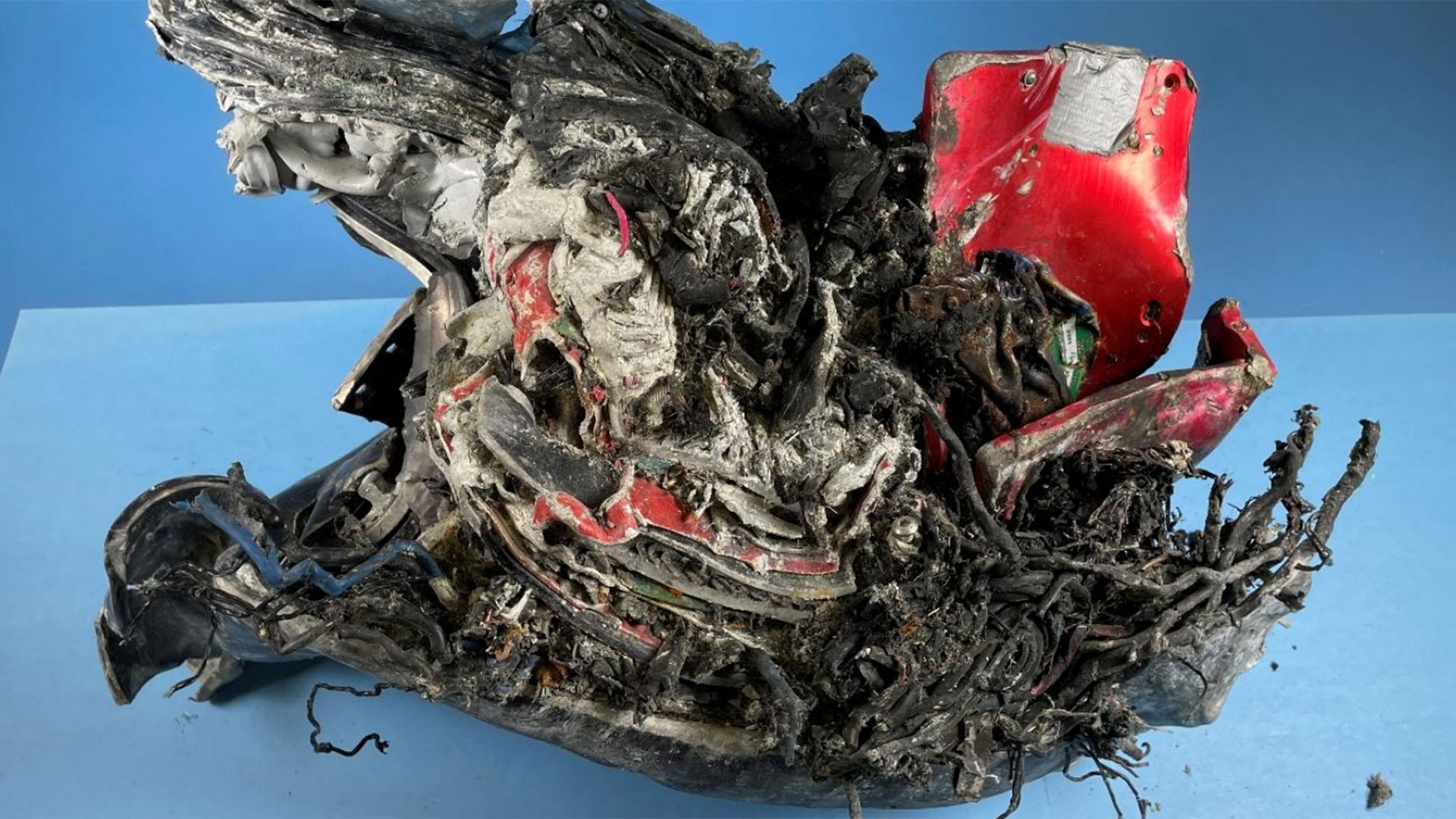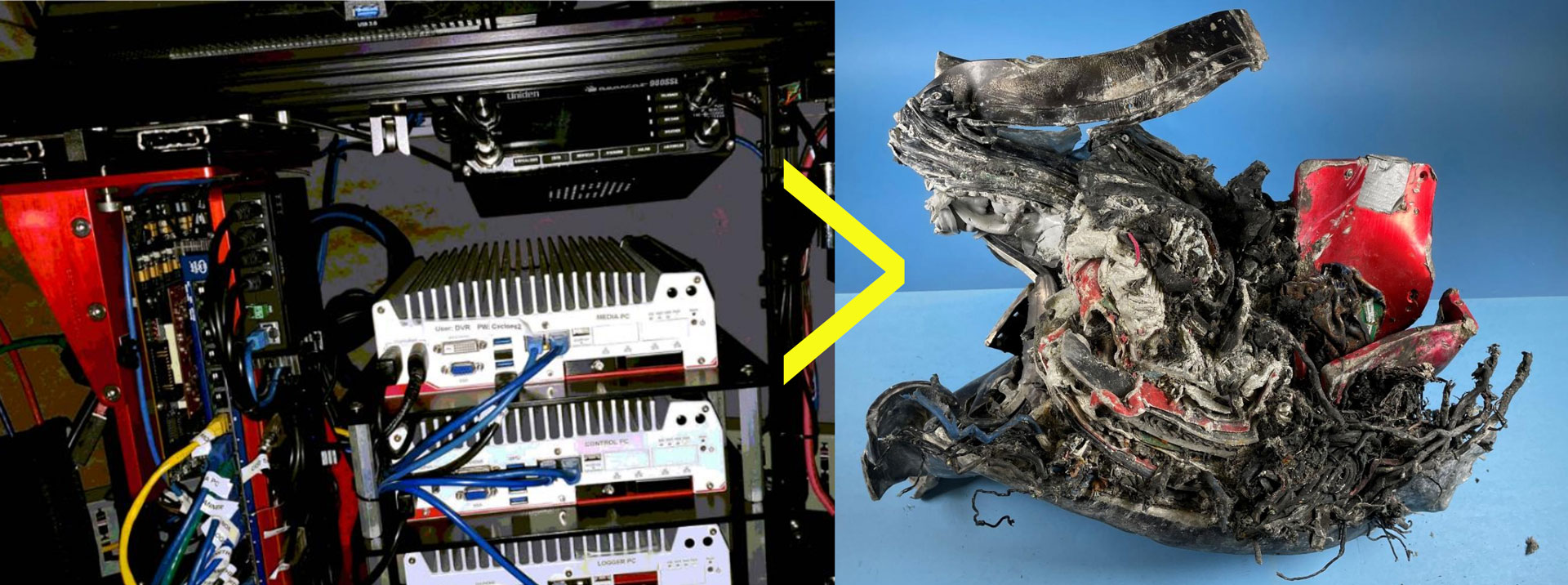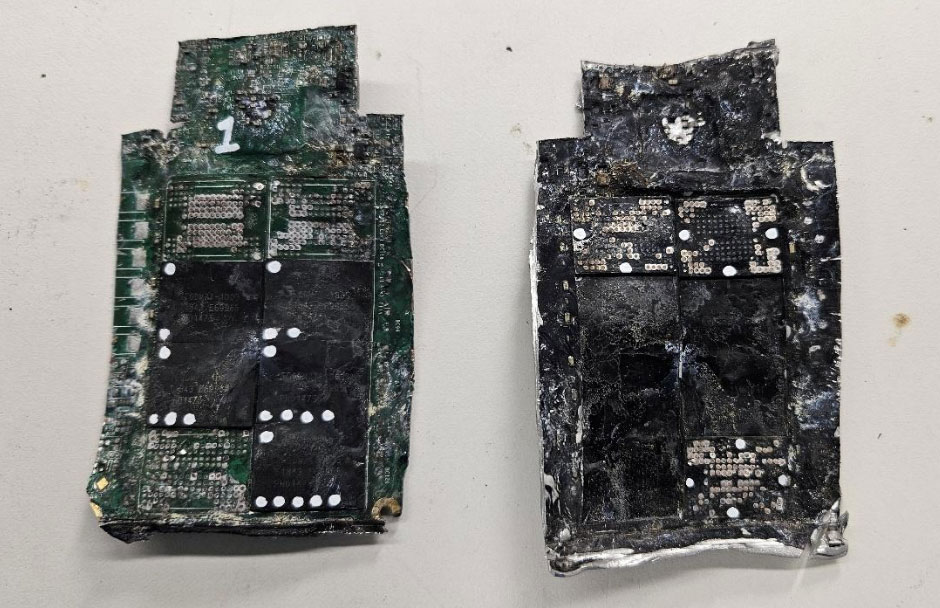OceanGate Titan submersibles' catastrophic implosion crushed its computers into twisted mass of metal and electronics — investigators find signs of thermal damage, too

The final report from the US National Transportation Safety Board (NTSB) regarding the implosion of the OceanGate Titan submersible in 2023 has now been published (h/t Scott Manley on YouTube). Earlier this week, we were surprised to see the tragic Titan submersible’s $62 SanDisk memory card found undamaged at the wreckage site. However, Docket #60 (PDF) of the final report shows that the computer equipment was far more severely damaged in the implosion. Specifically, the onboard trio of Nuvo-5000LP series fan-less PCs, for example, are almost unrecognizable in a “Large Electronic and Metal Mass.”

Above we can just about see some remnants of the red metal plating and cooling fins from the fanless Nuvo PC chassis.
According to the report, the above clump of electronic materials and their supporting structure(s) weighs approximately 100 pounds (~45kg). This used to be three Nuvo-5000LP series fan-less PCs that acted as the submersible’s mission computer. The OceanGate Titan computer system was used to log vessel performance as well as acoustic hull monitoring and other diagnostic information.
Page four of report Docket #60 shows a smaller, compressed mass of electronics. While some fabric or carpet seems to be visible in this lump, we are assured that “no human remains were externally visible anywhere on the mass.”
Investigations into the electronic remnants: CT scanning
Due to the extremely compressed, tangled nature of these two large remnants, the investigators decided to use computed tomography (CT) scans as a first step. They reasoned that “If the compressed memory components could be imaged in the CT scan, then a pathway could be established that provided a route for using destructive tools that could reach and extract the memory components.”
Of course, the thrust of the investigation was still to find out more about the Titan’s succumbing to the immense pressures it was under. So, they looked for ‘survivable space’ in the scans, where an SSD PCB could potentially survive intact.
Unfortunately, the third-party lab’s 320 kilovolts (kV) CT scanner couldn’t penetrate deep enough to find any ‘survivable void’ spaces, and no memory devices could be identified. The investigators ruled out using more powerful CT scanners as they thought the extra power could actually “damage data stored on any surviving NVM chips.”
Get Tom's Hardware's best news and in-depth reviews, straight to your inbox.
The ATF extracts two SSD PCBs
Eventually, the large mass was passed onto the Fire Research Laboratory (FRL) at the Bureau of Alcohol, Tobacco, Firearms and Explosives (ATF), notes the report. Eventually, the ATF extracted the two PCBs pictured below, thought to have come from a pair of 2.5-inch SSDs.

By the time of the source report’s publication, all data recovery efforts have been unsuccessful. It is explained that both PCBs saw deformations across three axes, and three BGA NVM chips were missing from each of the PCBs. Moreover, the remaining flash memory chips showed signs of cracks and distortion.
Finally, no data was forthcoming from similar investigations into the smaller electronics mass. Looking for storage components among electronics parts collected into Box One and Box 2, was also fruitless.

Follow Tom's Hardware on Google News, or add us as a preferred source, to get our latest news, analysis, & reviews in your feeds.

Mark Tyson is a news editor at Tom's Hardware. He enjoys covering the full breadth of PC tech; from business and semiconductor design to products approaching the edge of reason.
-
RolandScrotumvault While the system most likely wasn't the cause of the implosion, it does show that onlogic sells systems that a bootleg operation like oceangate would buy on the cheap.Reply -
FunSurfer Any device with air inside it will be crushed in implosion accidents like this in ocean depths. That reminded me about the guy who tested a GPU submerged in machine oil as a cooling solution, so maybe filling a computer box that is intended for undersea usage with non conductive liquid like that won't let it implode under pressure. Also make it run cooler.Reply -
bit_user Reply
If the machine is located inside a cavity, like the crew quarters, then the kinetic impact of debris striking the machine's cabinet should still cause tremendous damage. Perhaps you're right that a fluid filling will be more resistant to the damage, but I'd still expect a low chance of recovering readable NAND chips, even in that case.FunSurfer said:Maybe filling a computer box that is intended for undersea usage with non conductive liquid like that won't let it implode under pressure.
I'm somewhat surprised to read about the lengths they took to recover any data. CT-scanning is further than I'd have expected and I'm impressed they managed to recover those two SATA SSD boards. -
USAFRet Reply
If its in the same space as the humans, trying to take extra measures to protect the electronics against implosion is of no use if the human space collapses.FunSurfer said:Any device with air inside it will be crushed in implosion accidents like this in ocean depths. That reminded me about the guy who tested a GPU submerged in machine oil as a cooling solution, so maybe filling a computer box that is intended for undersea usage with non conductive liquid like that won't let it implode under pressure. Also make it run cooler.
The people are still dead, the computers don't really matter. -
bit_user Reply
Yeah, but aircraft do have those "black box" recorders for purposes of disaster analysis. The airplane already crashed, but lessons can be learned to better protect others, in the future.USAFRet said:If its in the same space as the humans, trying to take extra measures to protect the electronics against implosion is of no use if the human space collapses.
The people are still dead, the computers don't really matter.
That argument might hold less sway in the case of one-off custom submersibles, like this one. However, I think regulators might still have a good case for requiring they be equipped with some sort of implosion-resistant data recorder. -
USAFRet Reply
Right.bit_user said:Yeah, but aircraft do have those "black box" recorders for purposes of disaster analysis. The airplane already crashed, but lessons can be learned to better protect others, in the future.
That argument might hold less sway in the case of one-off custom submersibles, like this one. However, I think regulators might still have a good case for requiring they be equipped with some sort of implosion-resistant data recorder.
FDR and CVR are only applicable to commercial enterprises. Airlines.
The typical little Cessna that you or I could buy and fly has neither of those.
Or even more, an experimental aircraft build in my garage. -
bit_user Reply
Just curious if anyone has an idea how the cost of a properly-built deep sea submersible would compare to like a private jet.USAFRet said:The typical little Cessna that you or I could buy and fly has neither of those.
Or even more, an experimental aircraft build in my garage.
IMO, if you look at the trouble & expense that's going into recovering & analyzing the wreckage of OceanGate Titan, I think regulators would have a fairly good argument they use some form of standardized & appropriately ruggedized data recorder. -
USAFRet Reply
There have been multiple deep sea submersibles.bit_user said:Just curious if anyone has an idea how the cost of a properly-built deep sea submersible would compare to like a private jet.
IMO, if you look at the trouble & expense that's going into recovering & analyzing the wreckage of OceanGate Titan, I think regulators would have a fairly good argument they use some form of standardized & appropriately ruggedized data recorder.
https://en.wikipedia.org/wiki/Deep-submergence_vehicle
But when you try to techbro your way around real design ...all bets are off. -
bit_user Reply
I watched a video about the making of James Cameron's vehicle. The difference between his and OceanGate's is that Cameron assembled a team of experts and spared no expense to prioritize safety. Also, Cameron's was a single-person craft. So, it was only the safety of one person at stake, in any given mission.USAFRet said:There have been multiple deep sea submersibles.
https://en.wikipedia.org/wiki/Deep-submergence_vehicle
But when you try to techbro your way around real design ...all bets are off.
In contrast, the guiding principle of the OceanGate design was cost-savings - to such an extent that he ignored best practices, in the face of dire warnings by numerous experts.
Cameron put out a 3D blu-ray of footage filmed from his craft. I haven't watched it, because my 3D TV died, before I got the chance. I could watch the 2D version, but since I have a fair amount of 3D discs I still haven't watched, I'll probably either get my TV fixed or buy a projector that supports 3D. -
USAFRet Reply
Exactly.bit_user said:In contrast, the guiding principle of the OceanGate design was cost-savings - to such an extent that he ignored best practices, in the face of dire warnings by numerous experts.